Hot Fuzz’s Hidden Horror Influences

Spoilers for Hot Fuzz ahead.
Hot Fuzz is respected for its deconstruction of/homage to policework depicted in film. It valorises a realistic depiction of policework, while also indulging in the stylised violence of cop-centric action films like Point Break or Bad Boys II. What is less talked about, however, is the influence of other genres on Hot Fuzz. The film’s support of proper and diligent policework is shaped by horror narratives as much as police or crime fiction.
Hot Fuzz is about a skilled and perfectionist London cop, Nicholas Angel. He is transferred to a sergeant position in the country town of Sandford. Despite Sandford’s seemingly crime-free appearance, Angel suspects foul play when a series of gruesome “accidents” descend on residents of the town. Angel’s investigation leads him to the town’s shadowy Neighbourhood Watch Alliance (NWA), who have been ridding Sandford of citizens who are deemed undesirable to the town’s “model image”.
While the film has a typical murder mystery structure, a closer look uncovers influences of Italian giallo horror and British folk horror. Comparing Hot Fuzz’s narrative structure to the aforementioned European horror cinema traditions can give us insight into how Hot Fuzz blends genre narrative tropes to provide a new perspective on the role of the detective in crime stories. The detective in crime fiction uses rationality and modern ideals of justice to solve crimes, but Hot Fuzz demonstrates how a detective must accept the fallibility of rationality and justice. The evil forces in giallo and folk horror don’t abide by those rules, and neither do the NWA.
Giallo influences: subverting a typical crime story
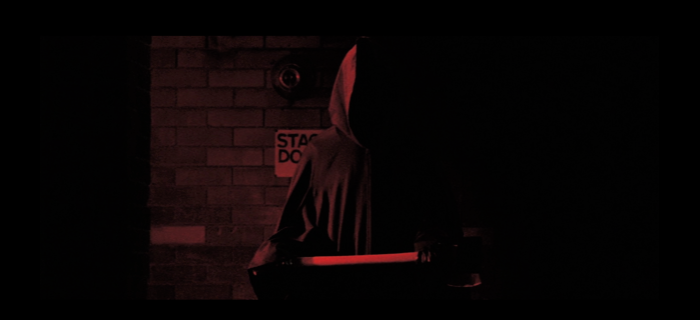
Hot Fuzz’s audience may expect a murder mystery, or whodunnit, plot during their first viewing. The whodunnit genre label refers to a type of crime fiction with two stories that converge at the conclusion. In a typical whodunnit, the first story takes place before the film’s beginning and details the motivations and methods behind the criminal. The events presented on-screen are called the second story and comprise the investigation into the crime. The second story concludes with the detective providing a detailed reconstruction of the first story.

The film provides viewers with clues towards a scheme for securing land rights. Angel then connects this motive to creepy supermarket owner Simon Skinner and leads the police force to him. Angel arresting Skinner and explaining his motive would be the ending of a typical whodunnit story. But this isn’t where the film ends. The true ending better resembles an Italian giallo film ending.
Giallo horror films were inspired by giallo novels written by Italian authors, who were inspired by American and British whodunnit stories. These novels diverged from the rational deduction method of American and British crime authors and were closer to Stefano Tani’s definition of anti-crime fiction. 1 Tani classified anti-crime fiction as a crime story that replaces the detective as the story’s centralising figure with ambiguity. 2
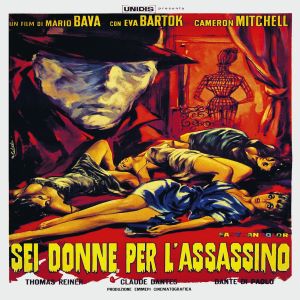
Giallo films of the ‘60s and ‘70s frequently made their mysteries more ambiguous by having multiple people be the killer. Blood and Black Lace (often considered the earliest example of a giallo film) reveals that the murders were committed by Count Morlachi and his wife working together. The Bird with the Crystal Plumage unmasks a gallery owner as the killer but subverts that by revealing he was working for someone who first appeared to be one of his victims: his wife. Neither film answers which murders were committed by whom among the multiple killers. Hot Fuzz uses a similar twist by having the culprits be the NWA, of which Skinner is a member.
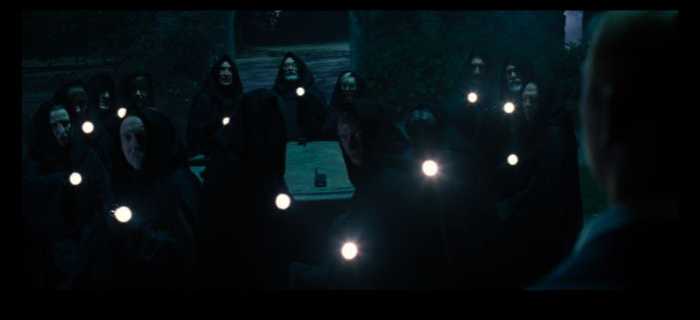
The first murder scene in Hot Fuzz (pictured above) deliberately uses typical imagery from giallos. The killer is disguised in a hood and all-black clothing, a common look for murderers in giallo films. The scene features bold and stylistic red and blue lighting, which emulates the highly theatrical lighting of Blood and Black Lace. The use of giallo iconography and lighting techniques orients the audience to the film’s giallo influences and invites them to interpret Hot Fuzz through the lens of a giallo.
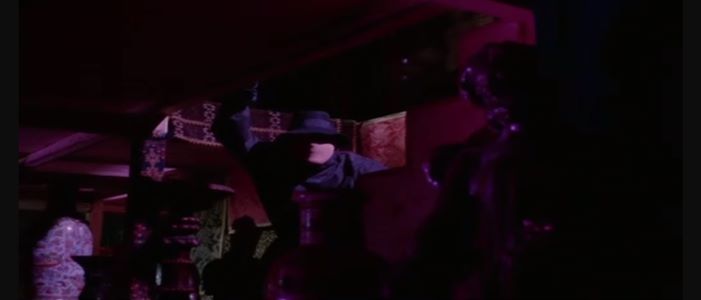
Interpreting Hot Fuzz through the lens of giallo reveals that a detective’s rational mindset can’t always explain violent or horrific acts. Anti-crime fiction unnerves audiences by presenting them with a solution that they cannot rationally accept. 3 The film uses dialogue and visual details to give audiences all the clues necessary to make Angel’s accusation of Skinner believable. The rational motive Angel constructed is disproven, however, meaning that a whodunnit story’s belief in rational detection is not at the centre of Hot Fuzz. Instead of a rational explanation, the audience is forced to accept that the NWA committed barbaric acts over something of little importance: winning a village of the year contest. Rewatching Hot Fuzz with the twist in mind allows the whodunnit plot to be recontextualised as a horror genre plot. Detective fiction revolves around using reason and rationality to give an explanation for the inexplicable. Horror narratives similarly involve confronting the inexplicable, but function by accepting, rather than disproving, the existence of something irrational.
Hot Fuzz and The Wicker Man: rural town horrors
In addition to giallo films, Hot Fuzz shares a lot in common with The Wicker Man. The latter is one of the three films commonly regarded as emblematic of the folk horror tradition, along with Witchfinder General and The Blood on Satan’s Claw. The common tropes of folk horror include a rural setting and a naïve outsider as the narrative focus. 4 The Wicker Man combines those elements with crime fiction elements. This makes it a more direct object of comparison to Hot Fuzz.
The similarities between Hot Fuzz and The Wicker Man begin with just the story beats. Sergeant Neil Howie, a devout Christian from the Scottish mainland, is dispatched to the small village-island of Summerisle in search of a missing girl. Summerisle’s people practice a variation of paganism, and repeatedly claim that there either is no missing girl or that the person has died. Howie, undeterred, uses investigative techniques to conclude that the missing girl is being held as a planned sacrifice for a plentiful harvest. The ending, however, reveals that the girl was just bait to lure Howie to the cultists; Howie is the planned sacrifice.
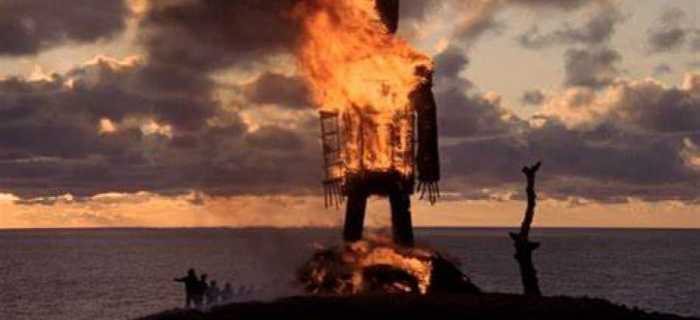
The Wicker Man’s plot, like Hot Fuzz, pits the detective against something that defies his personal beliefs. By extension, Summerisle becomes a horrific antithesis to modern conceptions of morality and civilisation. Paul Newland argued that rural settings in horror can act as spaces in which the ideologies of modernity and enlightenment might be challenged. 5 This idea of horror can easily be applied to Nicholas Angel’s confrontation with the NWA. The rational deduction that is prided in traditional crime fiction only came about after the Enlightenment, when criminology was established. Modern criminology posits that punishment should be determined by the crime. The NWA, on the other hand, execute Sandford citizens for the smallest of infractions.
Analysing Hot Fuzz through the lens of folk horror provides further clues to the presence of a dark force in Sandford. One of the first places that Howie visits in Summerisle is a pub, and Nicholas Angel visits a pub when he arrives in Sandford. Both police detectives face challenges to their worldviews within these bars. In Sandford, the bartender and his wife allow underage patrons to drink in their pub, because it prevents them from causing trouble out in town. The patrons of Summerisle’s pub, meanwhile, sing racy pub songs about young girls and fornicate outside, visibly disturbing the virginal Howie.
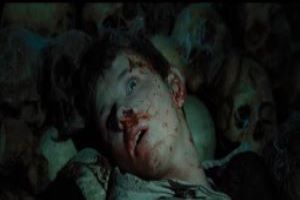
As outsiders to the rural communities, Angel and Howie want to impose their own beliefs of proper behaviour onto their environments. Howie resists the temptations of sex from the pub owner’s daughter, and Angel arrests and processes the children for underage drinking. Neither man knows that their actions support their respective environments’ violent cultures. Howie’s virginity is one of the qualities that makes him an ideal sacrifice. Angel arresting the children from the pub marks them for death by the NWA, with their corpses discovered among those of the NWA’s victims.
Defeating the horror: Nicholas Angel’s role as a horror protagonist
Nicholas Angel’s beliefs and methods, however, are not invalidated by the Hot Fuzz’s horror-influenced narrative. An investigative approach is still crucial to bringing him to the film’s climax. Art philosopher Noel Carroll observed that horror narratives frequently revolve around a process of proving, disclosing, discovering, and confirming the existence of something that defies existing conceptual schemas. 6 In Angel’s case, the NWA doesn’t believe in rationality and proper justice. Knowing that the central threat of Hot Fuzz defies rational conceptions, seemingly pointless moments suddenly become crucial to cracking the case. The petty reasons that the NWA give for killing their victims – horrible acting, an ugly house, or an annoying laugh – first appear as one-off jokes, shortly before each murder happens. These jokes, however, are clues towards the motives of the NWA: a first story to help us understand and prove the existence of something irrational lurking beneath Sandford. Angel’s commitment to rational investigation was necessary for finding the murderers, he just did not consider an irrational solution.
It’s only when Angel adapts to the town’s violent, pre-Enlightenment method for doling out justice that his idea of civilised justice prevails. Angel brings down the NWA members through violence so he can duly prosecute them for the murders they committed. Furthermore, Angel’s climactic showdown with the NWA represents the moment of confrontation with a horror monster once its existence has been proven and disclosed. 7
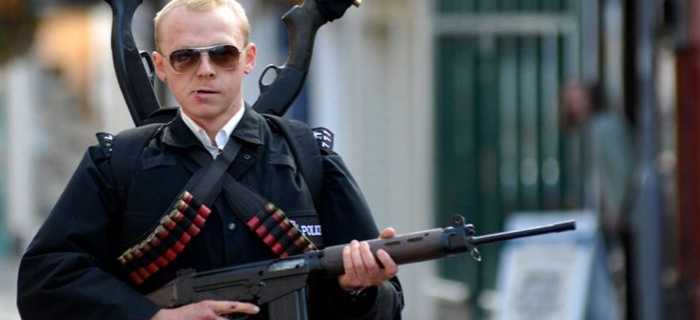
The European horror films I’ve analysed don’t have such satisfying conclusions as the one in Hot Fuzz. The murderers in Blood and Black Lace are never apprehended by the police, instead killing each other in a failed double-cross, while the protagonist of The Bird with the Crystal Plumage is saved at the last minute by the all-too-convenient arrival of the police. Howie doesn’t come close to surviving his encounter with evil in The Wicker Man. Angel, on the other hand, can defeat an irrationally minded and dangerous threat while remaining true to his principles.
Hot Fuzz demonstrates how genre narrative expectations determine a viewer’s interpretation of a story. A crime fiction protagonist is supposed to serve as the perfect guardian of rationality. The influence of giallos’ anti-crime fiction structure, however, undermines the rationality Angel, and the viewers, had trusted up to that point. Rewatching the film with knowledge of an irrational influence reveals that a monstrous presence had been lurking beneath an innocent rural community the whole time. Crime fiction and horror fiction protagonists both seek to confront frightening and/or violent presences within their communities. Analysing Hot Fuzz as a horror film rather than a crime film makes it a protagonist’s story of embracing irrational behaviours to properly defeat the horrific presence and restore order.
Works Cited
- Olney, Ian. Euro Horror: Classic European Horror Cinema in Contemporary American Culture. Bloomington, Indiana: Indiana University Press. 2013. ↩
- Tani, Stefano. ‘The Dismemberment of the Detective’ Diogenes. Vol.30. Issue 120. Pp. 22-41 ↩
- Ibid. ↩
- Murphy, Bernice M. ‘Beyond Midsommar: ‘folk horror’ in popular fiction’, The Irish Times. July 23, 2019 ↩
- Newland, Paul. ‘Folk horror and the contemporary cult of British rural landscapes: the case of Blood on Satan’s Claw’. British Rural Landscapes on Film, edited by Paul Newland. Manchester, England: Manchester University Press. Pp. 162-179. 2016 ↩
- Carrol, Noel. ‘Why horror?’. Horror: the Film Reader, edited by Mark Janovich. Oxfordshire, England: Routledge. Pp. 33-45. 2002 ↩
- Ibid. ↩
What do you think? Leave a comment.










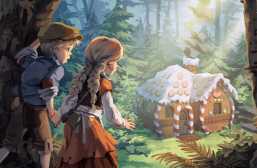
It’s interesting that you note the similarities between Hot Fuzz and horror films, because I know that the same people who made Hot Fuzz also made Shaun of the Dead, which is a parody of zombie apocalypse movies. It could be that horror is simply their main inspiration in general.
I think you are on to something. Maybe you are right about that horror is simply their main inspiration in general. I loved both Hot Fuzz and Shaun Of The Dead.
Most of the movie seems like a comedy where the characters act like they’re in a cop-action movie, but they’re really in a slasher. Then It goes full action after the reveal.
I definitely agree with this article, great work.
It is a dissection of police films. The buddy cop dynamic, the action tropes, the mystery, murder, and suspense of thrillers. But most importantly, the paperwork. There’s some psychological drama in there too.
It has elements of a lot of genres. And I honestly believe with different editing, it could easily be rearranged to be more horror based, or more action. They really could have gone many ways.
I think all the films in the trilogy are primarily comedy films, and I wouldn’t distinctly call Hot Fuzz a comedy / horror.
The thing about Hot Fuzz is that it’s a pastiche of several different types of cop movies. Mystery thriller with brutal violence, detective drama with lots of suspects and interviews, buddy cop comedy, buddy cop action…
It smashes all these into one film that’s also a comedy. So there’s not much room for horror here, but “mystery thriller with brutal violence” often uses a lot of horror tones and tropes. So basically 1/4-1/3 of the film is a tribute to a genre that overlaps with horror in some ways.
So not a horror film, but definitely traceable ties to the genre.
I’ve always thought of it as an action-comedy parody of Midsomer Murders. And if you haven’t watched that show, please do because it’s amazing, and it definitely has horror elements but it’s also funny and pretty low-key.
Kept me up at night when i was younger. For a huge portion of my childhood i was traumatized by the death scene by the church. I didn’t remember the other parts of the movie, i didn’t finish it, i had no idea what the movie was – i was just extremely anxious whenever i remembered the scene. Time flies by and at 17 i visited my brother. We had kfc and he turns on this movie labelled as comedy on netflix. I was a bit shocked to find out that the scene i was so scared of as a (younger) child was hot fuzz, a film i thoroughly enjoyed later on in life.
I’d say it’s a movie that doesn’t limit itself in useless barriers and i support it wholeheartedly. It’s a great movie with a great idea that needed more elements to become a thing.
I consider it a masterpiece… but more on the outskirts of horror.
Absolutely brilliant movie in so many ways. Saw an interview with Simon Pegg, the other day, where he said he liked World’s End best of the Cornetto trilogy, but sorry mate, you’re obviously deluded there.
Hot Fuzz is one of my fave movies of all time. Thank you for writing this article. This movie just keeps giving with each viewing.
One of my favorite movies, up there with every Edgar Wright movie, Inception, Fight Club and Pulp Fiction.
I just Finished the cornetto trilogy and Hot fuzz is my favourite!
Hot Fuzz is my favorite Hallmark movie. lol
It’s about a career-obsessed person from the city who is transferred to a small-town in the country. He is initially put-off by their small-town rural values, but learns to adjust to it with the help of a hunky friend/love-interest. All with a takeover from the city happening in the background.
A small town with a dark secret is the essence of horror. Even if it’s all for the greater good.
Yes and once we get to the neighborhood watch folks in druid cloaks acting like an evil cult, we’ve gone full into horror territory.
The film absolutely has a great deal of horror elements. Genres aren’t really as binary as people make them out to be. Hot Fuzz is a big genre mashup paying homage to action, noir, and horror (think classic giallo murder mystery /horror!!) through the lens of comedy. To deny the obvious genre range is just being weirdly obtuse. The whole Cornetto trilogy is spoofing multiple genres per film.
If wicker man is horror so is hot fuzz. Fight me.
The attention to detail and dedication of this film is incredible.
I think I would consider it comedy-action first and foremost but there’s definitely a secondary flavor of horror in there.
Remind me a little touch of Dario Argento’s italian thriller style (in the secondary flavor of course).
On a rewatch the horror elements are palpable. Theres a scene where Nicolas is desperately trying to convince his colleagues that somethings amiss in the town (immediately before he fights with rory mccann) and in the background of the scene you can see the NWA there watching and listening, it’s so damn creepy!
I also consider Shawn of the Dead as an instant classic, definitely recommend Worlds End to top off the Ice Cream Cone Trilogy
Worlds End is the only one I haven’t caught yet, but definitely on the watch list.
I fully back that Hot Fuzz is a horror movie. As broken down in this piece, watch the original Wicker Man from the 70’s and it has a lot of the same tropes and flavors.
The whole point of Hot Fuzz is that there is no one main genre. It’s everything. Wright describes it as a Trojan Horse film. If a ceiling pillar landing on someone’s head causing blood to splatter everywhere isn’t horror then I guess I don’t know what is.
I think that just having some horror elements doesn’t necessarily make it a horror film. A lot of action movies use what could be considered horror elements to ramp up suspense.
The first time I saw it (I was quite young) some bits did freak me out (especially the guy impaling himself through the chin on the model church…) so you could say it has horror elements, despite primarily being a comedy.
That part was hilarious I still crack at that scene to this day,…”I need ice” ahaha
I have indeed always considered it horror though, even if comedy is primary. It very clearly homages The Wicker Man (even Edward Woodward is in it), and there is enough gruesomeness and some genuinely tense moments that are enough to make it deserving of the horror title. I would say the entire cornetto trilogy falls into the horror comedy genre, with The World’s End being the least horror of the three but still enough to classify!
The best part about this movie is just how much of the last act is obviously foreshadowed, and yet it doesn’t shove it in your face. A lesser movie might linger on those little moments of foreshadowing and really shove it in the viewer’s face to make sure they get it, but Hot Fuzz respects its audience and itself enough to just let those moments go by without putting undue attention on it. The result is a movie that’s not only tremendously funny and clever, but also a movie that is genuinely engaging to rewatch at least once. Shaun of the Dead and World’s End do this too, of course, but neither did it as relentlessly yet casual as Hot Fuzz.
Whenever anybody asks me what my favorite movie is I always say “Hot Fuzz.” and they always reply back “what’s Hot fuzz?” …which of course makes me very sad… but it’s not that you HAVE to watch it 37 times to appreciate it, it’s that if you DO watch it 37 times you will still find things to appreciate
The phenomenally constructed, multi-layered textures of this film, mean that whenever I run into it on TV, I always stop whatever I’m doing and pivot to watch it. It is simply GLORIOUS. There isn’t a single weak link in it – from performance, to script, to cinematography, to direction, to editing – it’s all just brilliant isn’t it? And you can tell it’s been crafted by someone who knows and loves film. The sheer number of Chekov’s Guns in this film is a work of art in itself, aside from everything else…
Hot fuzz is one of my favorite movies of all time. I’m a little uncomfortable that I like it more than Shaun of the dead.
This film literally took over my heart and 99% of my brain space.
Hot Fuzz is probably my favorite movie of all time. There are better ones, there are ones I watch more often but Hot Fuzz is a the movie I go to when I just need to cheer up, when depression hits so hard I don’t open my shades because I don’t deserve sun, I watch this movie. It makes me laugh so hard, every damn time.
One of my favorite details of the movie is the rifle that Angel when he gets all of his weapons from the police station is the FAL, otherwise known as the right arm of the Free World. It was created by NATO to be a weapon not for war, but for keeping the peace, which is the perfect weapon for the perfect peacekeeper of Angel.
Honestly I wish all the police in this day and age would watch this movie and take notes.
There was a distinct moment in Hot Fuzz where I was like, “Is he going to wind up inside a wicker man?” but it subverted that.
Same story set up to. A sargent from London goes to a rural community and uncovers murders the locals have been covering up
It’s an action-mystery-comedy with some solid horror elements. I guess Edgar Wright still wanted to do horror after Shaun of the Dead.
The way I see it it’s a horror movie the same way Assault on Precinct 13 is a horror movie. Not technically and I would never classify it as one, but it has some horror elements which work really well.
I’d say it is horror-adjacent as a lot of these murder mysteries tend to be.
I mean, crime stories are very linked to the horror genre. Both stems from the tradition of Gothic literature after all.
There’s a reason why, say, Batman is basically the perfect blend between Sherlock Holmes and H.P. Lovecraft at times.
This movie is good but it over stays it’s welcome and goes on way to long as so I can only watch it once every ten years or so.
Cant even tell you how many times I’ve watched this movie. I don’t know when I discovered Simon Pegg, but I don’t remember life without him.
I love how many references were chucked into the one film, yet it still feels original!
Tremendous film and analysis. Thank you for the fascinating read.
Hot fuzz shaped my sense of humour growing up, bizarre to see how horror genres influenced the thing.
I’ve watched this movie so many times and have enjoyed breaking it down with friends who are equally obsessed with horror. You’ve done an amazing job here of connecting so many points! Thank you for the detailed writing, amazing read!
Edgar Wright makes the best widely known movies honestly. Most of them have a swift witty humor that should be enjoyed more than once.
Love this movie. Very Interesting article.
This is an interesting take. I am trying to learn more about classic horror structures, as they are very formulaic to me, and I want to understand how the formula works.
Excellent piece. I always enjoy watching this movie.
This movie will never not be a classic, I watch it probably once every 18 months
As a film student, I completely agree with your take on the movie. Despite its comedic and action movie-like stereotypes, there are many instances where the film plays on different horror movie archetypes.
Just watched The Wicker Man in my movie club, and I was thinking about Hot Fuzz the entire time, especially during the pub scene. Glad to see I wasn’t the only one!